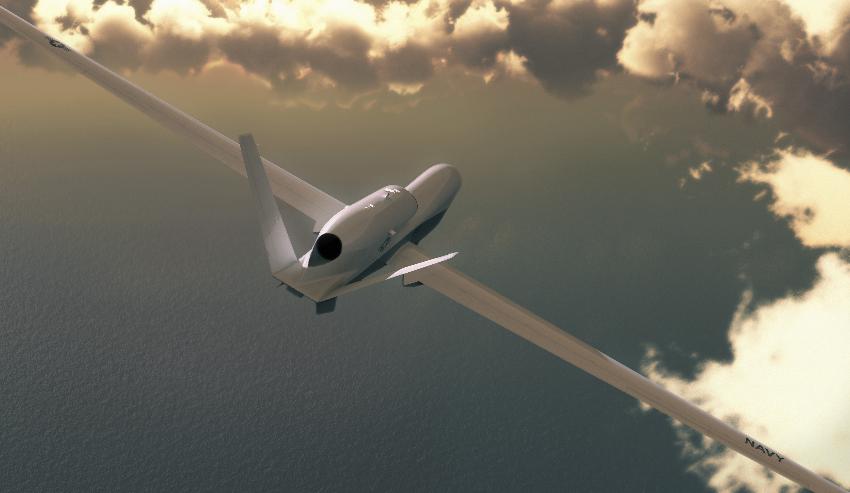It was revealed late last week to a shocked defence community, however Northrop Grumman remains upbeat about Australia’s future Triton acquisition after revelations that the US government had ‘paused’ production of the MQ-4C Triton.
When announced in mid-2018 by then prime minister Malcolm Turnbull, the $1.4 billion proposed acquisition of six Northrop Grumman MQ-4C Triton unmanned aerial systems was billed as a major coup in the nation's pursuit of a fifth-generation, multi-domain defence capability.
Remotely flying out of RAAF Edinburgh, South Australia, the Tritons are capable of monitoring 40,000 square kilometres a day and seamlessly flying a round trip for sustained surveillance and in support of allied freedom of navigation operations in the South China Sea from the Northern Territory – increasing Australia’s interoperability with key allies, particularly the US.
The Triton is designed to operate in conjunction with Australia’s planned fleet of 12 manned P-8A Poseidon maritime patrol and anti-submarine aircraft.
Turnbull described the delivery timeline as it stood in 2018: "The first of the Triton aircraft is expected to be introduced into service in mid-2023, with all six aircraft to be delivered and in operation by late 2025, based at RAAF Edinburgh, South Australia."
Expanding on this, the 2016 Defence White Paper explained the importance of the Triton platform as it fits within the Australian Defence Force:
"To complement the surveillance capabilities of the [P-8A] Poseidon, the government will acquire seven high altitude MQ-4C Triton unmanned aircraft from the early 2020s … The Triton is an unarmed, long-range, remotely piloted aircraft that will operate in our maritime environment, providing a persistent maritime patrol capability and undertaking other intelligence, surveillance and reconnaissance tasks."
Despite the recent announcement that Australia was to contract its second of six MQ-4C Triton with the US Department of Defence and prime contractor Northrop Grumman, revelations that the US government had 'paused' production of Australia's platforms has been met with a range of responses.
Indeed, Marcus Hellyer, ASPI senior analyst for defence economics and capabilities, raised some concerns about Australia's continued acquisition of the MQ-4C Triton, stating, "The pause is unfortunate for Australia for several reasons. Our first Triton should be delivered before the pause takes effect, but overall the goal of initial operational capability in 2023-24 and final operational capability by 2025 look like taking a two-year hit. That’s the best-case future.
"It could be worse. The US is much more willing to cancel programs than Australia is. And the wolves pick off the stragglers. Germany left the program earlier this year. The Triton has already suffered a 61 per cent increase in development cost and a 70 per cent increase in acquisition schedule, so with a two-year production pause on top of that plus the cost of restarting production, it’s looking more and more like an easy target for budget predators."
Hellyer adds, "It could be worse again. There’s some talk of Australia jumping in and filling the production gap by acquiring its remaining aircraft earlier. But this ‘opportunity’ may be a trap. When the production pause occurs, the US Navy will have received 14 of the 65 originally planned aircraft ... Even worse, the US Navy may well decide it’s not worth operating its rump fleet and cancel everything, leaving Australia in the impossible position of holding six or seven orphan aircraft and the entire future cost of supporting the capability after we’ve gone all in for $3-$4 billion.
"The sunk cost fallacy suggests it could be better to cut our losses and get out now, even if we have spent hundreds of millions already."
However, speaking to Defence Connect, Northrop Grumman Australia chief executive Chris Deeble remained optimistic about the future acquisition, stating:
"The United States’ President’s 2021 budget proposes to significantly increase funding for the multi-intelligence configuration of the MQ-4C Triton aircraft system, known as IFC-4. At Northrop Grumman we will work closely with our US Navy customer and our suppliers as this capability meets the critical needs of our warfighters and international partners.
"The budget also proposes pausing production of Triton in 2021 and 2022 while the development of IFC-4 is completed. The Triton industry team recognises that pausing production would have a negative impact on the timely delivery of this capability to the warfighter and we are committed to working with various stakeholders to sustain Triton production, and ensure our US and Australian customers receive this critical capability."
Expanding on this, Deeble said that the production pause could present significant opportunities for the Australian Defence Force, stating, "The proposed production pause may represent an opportunity for the Australian government to bring the Triton capability forward, while ensuring affordability.
"Production slots opened up by the US Navy could potentially be filled by Australian aircraft. This would ensure earlier delivery of assets to Australia while protecting affordability for both Australia and the United States."
It is expected that the Tritons will provide a quantum leap in the nation’s surveillance and reconnaissance capabilities, while the facilities and crew required to operate, train and maintain will be part of the initial $1.4 billion investment, which includes $364 million on new facilities at RAAF Bases Edinburgh and Tindal (in NT).
Deeble added, "The Triton program is progressing well, with two aircraft now in Guam, representing the first operational deployment of Triton, allowing the system to provide vital maritime ISR capabilities in one of the world’s vital trade regions. These two aircraft are the first in what is planned to be a 68 aircraft fleet providing critical 24/7 maritime surveillance for the US Navy around the globe.
"Triton is able to maintain over-watch and relay near-real-time data to allow manned systems to act on relevant intelligence. No other system could replace the high-altitude long endurance capabilities provided of Triton. This system will vastly enhance Australia’s common operating picture and ability to protect its national interests across the maritime domain."








